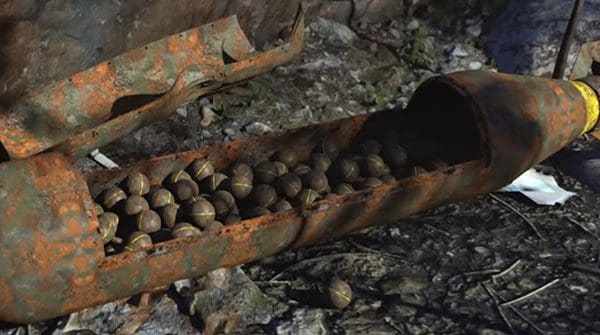Biden’s decision to supply Ukraine with cluster bombs doesn’t bode well for Ukraine’s 2023 campaign
 As I observed in my last Troy Media commentary on the Russia-Ukraine War, she who forgets or ignores the past risks having it repeat.
As I observed in my last Troy Media commentary on the Russia-Ukraine War, she who forgets or ignores the past risks having it repeat.
Last week, U.S. President Joe Biden authorized the supply of cluster munitions to Ukraine. Because of the long-term threat they pose to post-conflict civilian safety, cluster munitions, which saturate an enemy position with bomblets (submunitions), are used by only a few states.
Early marques of submunition were prone to malfunction. Today’s iterations are more reliable (although Russian submunitions are less reliable than most). Consequently, there is less chance that unexploded submunitions will pose a long-term threat to civilians. Because bomblets look like toys, children are at greatest risk.
Canada is a signatory to the 2008 Convention on Cluster Munitions. On hearing of Biden’s decision, the Canadian government stated: “Canada championed the adoption of the Convention on Cluster Munitions, which is now ratified by more than 100 countries …. We do not support the use of cluster munitions and are committed to putting an end to the effects cluster munitions have on civilians – particularly children”. As demonstrated in the video of three air drops of cluster munitions below, the weapon is devastating.
 |
| Related Stories |
| Ukraine needs Apache gunships, not a premature call for reconstruction
|
| Western geopolitical failures led directly to Putin’s War
|
| Russia vs Ukraine: Is diplomacy dead?
|
There are two reasons for Biden’s decision to supply Ukraine with cluster munitions, neither of which bodes well for Ukraine’s 2023 campaign.
First, Ukraine is running low on artillery shells. Because Western states are unable (or unwilling) to quickly ramp up production of war materiel, Ukraine faces the prospect of prosecuting its 2023 offensive (there will likely be a 2024 offensive and, possibly, a 2025 offensive) with a rapidly dwindling supply of artillery shells. As Biden told CNN on July 7: “It was a very difficult decision on my part (to supply cluster munitions). And by the way, I discussed this with our allies …. The Ukrainians are running out of ammunition”.
Secondly, because of their ability to saturate a target, cluster munitions can degrade minefields and trenches. Russia’s 1,000 km-long line of contact (LOC) with Ukraine is peppered with minefields and elaborate trench systems. The suppressive character of cluster munitions will give Ukraine’s engineer platoons more time to clear paths through minefields. Currently, Ukraine’s engineers are doing this under fire. Lives and scarce mine-clearing armour are being lost.
There has been much hyperbolic comment about Ukraine’s 2023 offensive – a matter, perhaps, of the heart ruling the head. In a recent address to the U.S. National Press Club, General Mark Milley, Chairman of the U.S. Joint Chiefs of Staff, provided journalists with a realistic prognosis for Ukraine’s offensive. Said Milley: “War on paper and real war are different …. Real people are on those front lines and real people are in those vehicles. Real bodies are being shredded …. [T]his is going to take six, eight, 10 weeks …. It’s going to be … very, very bloody. And no one should have any illusions about any of that”. Milley’s speech provided a long-overdue antidote to journalists’ jingoistic hyperbolizing. War is hell-on-earth … and unpredictable.
Those who forget that war is hell-on-earth should study the Pacific campaign of the Second World War (or Great Patriotic War), specifically the number of soldiers, sailors, airmen and civilians killed and the volume of materiel lost during America’s island-hopping campaign.
On the Japanese home island of Okinawa, American commanders faced a similar challenge to that currently faced by Ukraine’s commanders: how to rout an enemy that is well dug in and determined to resist. Unlike Ukrainian commanders in 2023, American commanders in 1945 had ample resources, from ships and aircraft to soldiers and ammunition. To prosecute one of the biggest campaigns of the Second World War, America assembled a naval force of 1,321 vessels, from battleships and carriers to submarines and troop transports, and an invasion force of over 180,000 young, well-fed and well-equipped soldiers. American carrier-borne aircraft were able to bomb and strafe at will, there being no effective Japanese air defence.
Nevertheless, General Mitsuru Ushijima held his defensive position – known as the Shuri line – for three months, bleeding General Simon Bolivar Buckner of men and materiel, much as Russia is doing to Ukraine today.
Some have suggested landings behind the Shuri Line might have delivered victory sooner. The island’s topography would have made such landings difficult, however. As noted in the United States Army Centre of Military History’s Okinawa: The Last Battle: “(Buckner’s) staff officers … considered the … plan too hazardous; the troops would come up against strongly held Japanese positions in an area where the terrain favoured a strong defence, and the (amphibious) landings could not be supported by artillery”.
During the frontal assault on the Shuri line, the U.S. Army suffered 4,412 killed and 17,689 wounded, and the U.S. Marine Corps 2,779 killed and 13,609 wounded. It is noteworthy that the U.S. sustained these casualties despite having control of the skies over Okinawa and an almost inexhaustible supply of troops, ammunition, aircraft, general war materiel, food and the myriad other items required to sustain an army in the field. Today, Ukraine is using the same tactic – a frontal assault – to breach Russia’s fixed defences without:
- control of the skies
- adequate numbers of fixed and rotary-wing aircraft
- adequate ammunition
- adequate fire-support
- adequate numbers of youthful, experienced soldiers.
Allies, take note.
Those who strive to improve public safety place great store in active learning – that is, in learning lessons from the past and applying them to current practice. The bloody Okinawa campaign holds lessons for Ukraine and its allies.
Dr. Simon Bennett directs the Civil Safety and Security Unit at the University of Leicester. He’s interested in the organizational, social, economic and political origins of risk. He has worked with the Royal Air Force and U.K. National Police Air Service on human factors issues. His latest book, Safety in Aviation and Astronautics: A Socio-technical Approach, was published by Routledge in 2022.
For interview requests, click here.
The opinions expressed by our columnists and contributors are theirs alone and do not inherently or expressly reflect the views of our publication.
© Troy Media
Troy Media is an editorial content provider to media outlets and its own hosted community news outlets across Canada.